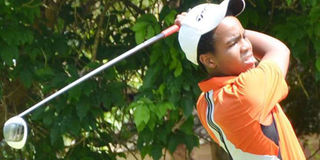Enjoy the new year, and the new laws too

Mathew Wahome follows his tee off during the Nyali Open on December 12, 2015 at Nyali Golf Club. Under the new Rules of Golf, a player has to have done something that caused the ball to move in order to incur the one-stroke penalty. PHOTO | NATION MEDIA GROUP
What you need to know:
- If the ball moved after the player addressed it, he suffered a one-stroke penalty and was required to replace it.
- Under the new rules, the player has to have done something that caused the ball to move in order to incur the one-stroke penalty.
- A ball to be lifted under the Rules may be lifted by the player, his partner or another person authorised by the player.
The new Rules of Golf take effect today.
Following the article on the changes in last week’s column, I received a few questions that revolved around two issues.
One, when is the player deemed to have moved the ball? Two, why must one give his caddie permission to mark their ball?
Starting today, a golfer will not be penalised for the ball moving after address under Rule 18-2 (Ball at Rest moved by Player, Partner, Caddie or Equipment).
In pre-shot routines, a few golfers will place the club lightly behind the ball, step back and make a few practice swings.
Placing the club lightly behind the ball is, under the definitions of the rules, addressing the ball.
Until today, if the ball happened to move after addressing it, you were on the hook.
The only saving grace in this case would be something like a gust of wind.
You could not have been saved by a claim that it was the slope of the ground or gravitational pull.
If the ball moved after the player addressed it, he suffered a one-stroke penalty and was required to replace it.
Under the new rules, the player has to have done something that caused the ball to move in order to incur the one-stroke penalty.
BALL MARKING
Even if the player addresses the ball, they will only be penalised if the move is attributable to something they do from now on.
If the player, for example, was practising putting on the green and in the process moved the ball without intending to strike the ball, he incurs a one-stroke penalty and must replace the ball.
The ball just needs to have come to rest in a new position for it to be considered to have moved.
Unlike popular belief, it does not need to make a complete revolution.
Must one give his caddie permission to mark a ball?
This one, unlike what some of the readers thought, is not a new rule. Rule 20-1 says;
A ball to be lifted under the Rules may be lifted by the player, his partner or another person authorised by the player.
An important part of the new Rules of Golf lies between page 30 and 45.
This is the part that covers the definitions.
The definition covers "caddie" and "partner" and the two are not used interchangeably.
Therefore, a Caddie falls in the category of “another person authorised by the player”.
SUCCESS DEAR GOLFERS
I took advantage of this rule recently in a match against an eager golfer who thought that he did not need my permission to mark my ball.
He arrived on the green before I did and since my ball was on his line of putt, he went ahead marked it without seeking my permission.
I informed him of the breach and that he incurred a one-stroke penalty.
I’m not sure I will get another chance to play with the good golfer again.
He claimed that I only defeated him through the use of the rules.
There is a downside to knowing and applying the rules.
This year, as you strike the small, dimpled ball, may your drives be straight and far.
May birdies and pars abound. May all the hooks, slices and air shots only appear in your nightmares. Have a wonderful 2016.




